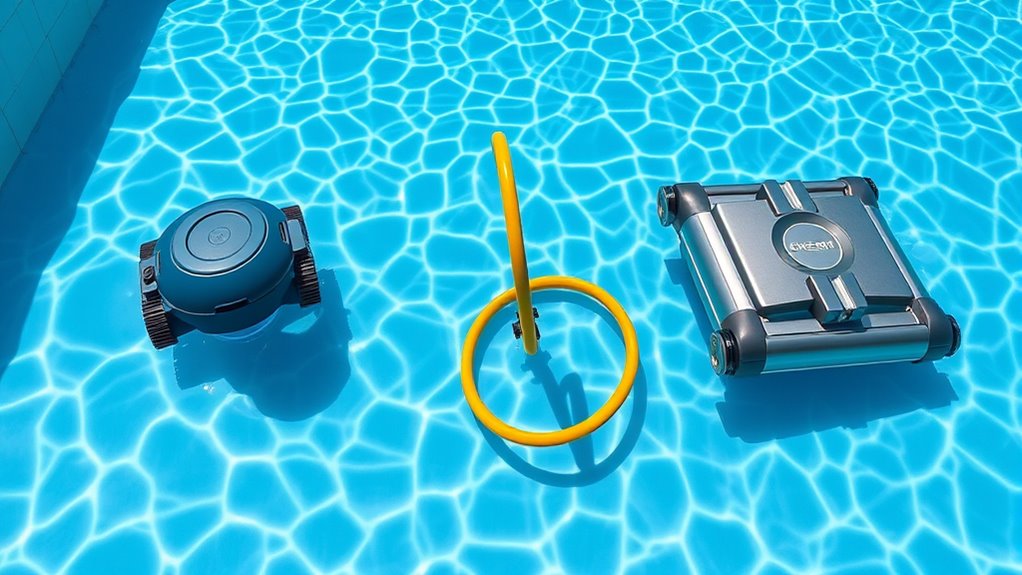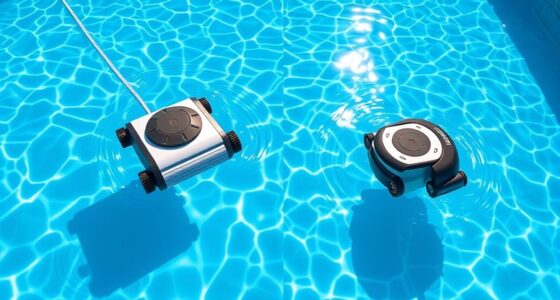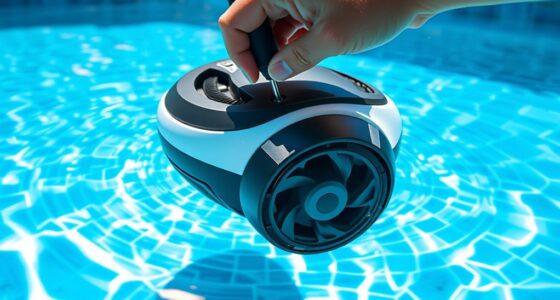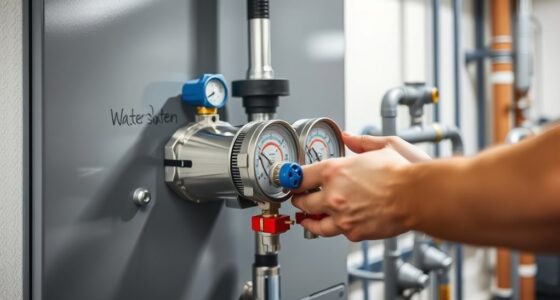Automatic pool cleaners help keep your pool clean with minimal effort. There are three main types: robotic cleaners, which operate independently using advanced technology; suction-side cleaners, connecting to your skimmer and relying on your pool’s filtration system; and pressure-side cleaners, using pump pressure to gather debris. Each type offers different advantages for maintenance and efficiency. To find out which one best suits your pool, explore the options further below.
Key Takeaways
- Robotic cleaners operate independently with advanced technology, requiring regular maintenance like filter cleaning and software updates.
- Suction-side cleaners connect to skimmers, relying on existing filtration systems for energy-efficient pool cleaning.
- Pressure-side cleaners use pump pressure and connect to return jets, collecting debris with minimal maintenance.
- Regularly check and clean filters, debris compartments, and sensors to ensure optimal performance of all automatic cleaners.
- Understanding different types helps choose the right cleaner based on pool size, debris level, and maintenance preferences.
Robotic Pool Cleaners

Robotic pool cleaners have revolutionized the way you maintain your pool by offering an automated solution that requires minimal effort. These devices use advanced pool cleaning technology to efficiently scrub floors, walls, and waterlines without your direct involvement. To keep your robotic cleaner working best, follow some simple maintenance tips, such as regularly emptying the debris compartment and inspecting the brushes for wear. Make sure the sensors and filters are clean to prevent malfunctions. Since robotic cleaners are designed to operate independently, you can save time and energy while ensuring your pool stays spotless. Understanding how these cleaners work helps you choose the right model and keep it running smoothly for longer. Proper sensor calibration is essential for optimal performance, especially when dealing with complex pool shapes or varying debris levels. Additionally, regular updates to the device’s software can improve navigation algorithms and efficiency over time. Incorporating AI-powered features can further enhance cleaning precision and adaptability. Regularly reviewing the maintenance requirements ensures your robotic cleaner remains effective and prolongs its lifespan.
Suction-Side Pool Cleaners
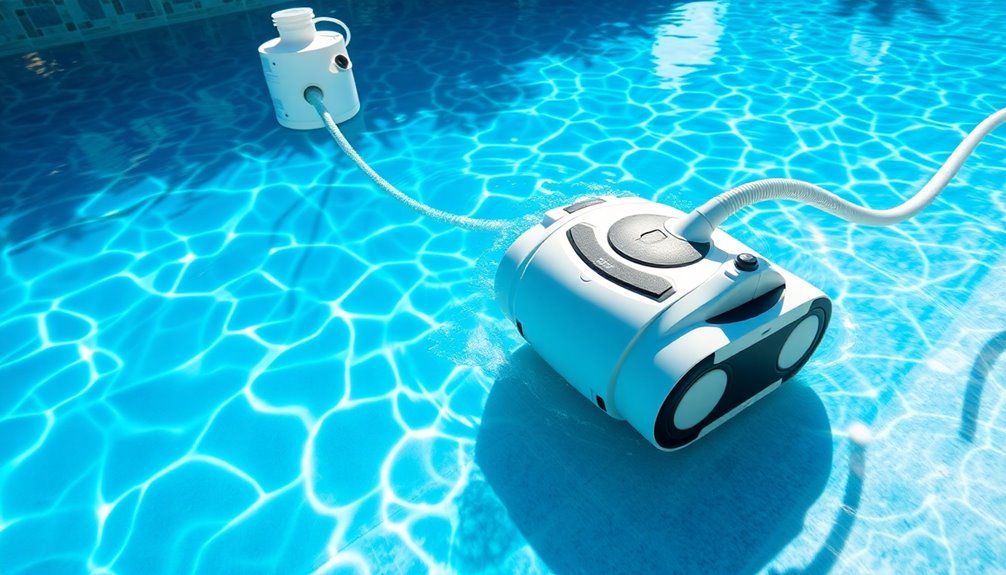
Suction-side pool cleaners are a popular choice for effortless pool maintenance because they use your existing filtration system to power their cleaning actions. They connect directly to your skimmer or dedicated suction port, making installation straightforward. These cleaners are generally energy-efficient, as they rely on your pool’s pump rather than requiring extra power sources. Maintenance requirements are minimal; you’ll need to regularly check and clean the filter bag or basket to ensure peak performance. Since they depend on your pool’s filtration system, their cleaning effectiveness can vary based on your pool’s size and pump capacity. Proper water circulation is essential for maximizing their cleaning efficiency. Additionally, understanding your pool’s filtration system can help optimize the cleaner’s performance and longevity. Regularly inspecting and maintaining the filter components can also prevent blockages and improve overall cleaning results. Since they utilize your existing equipment, choosing the right type of pump capacity can significantly impact their cleaning ability. Proper filter maintenance ensures consistent operation and prolongs the life of your cleaner. Suction-side cleaners are ideal for routine cleaning and are often more affordable upfront than other types, making them a practical option for many pool owners.
Pressure-Side Pool Cleaners
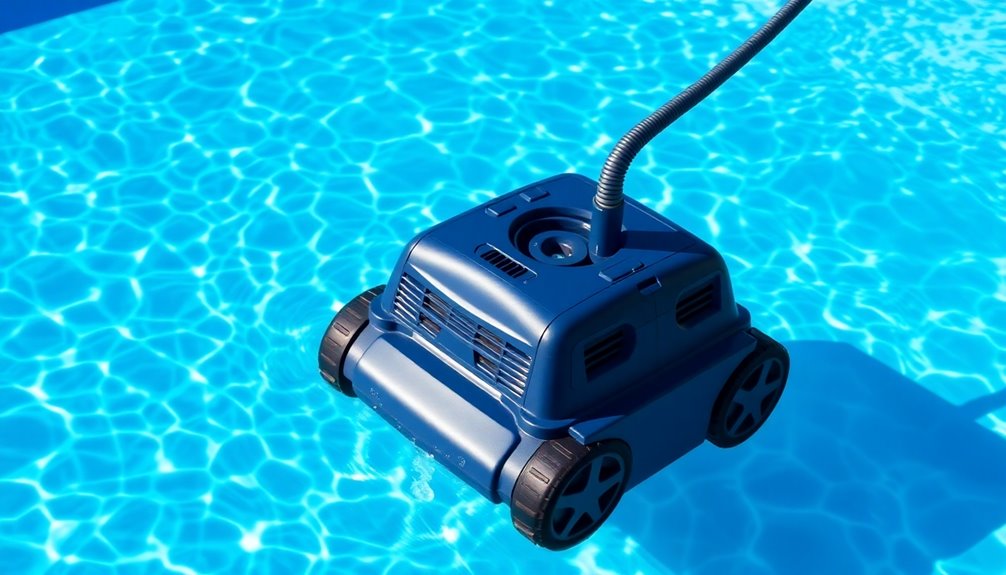
Pressure-side pool cleaners connect to a dedicated return jet or hose line, using your pool’s pump pressure to navigate and gather debris. This setup makes them more energy-efficient than some other types because they rely on existing pump power rather than extra motors. They typically require less maintenance since their debris bags are easy to access and clean, reducing downtime. Additionally, organized spaces can help streamline maintenance routines and improve overall efficiency. Proper pool equipment placement can also enhance the cleaner’s performance and longevity. Understanding the importance of personality traits such as resilience and adaptability can help in selecting the right cleaning system for your needs. Moreover, selecting the appropriate filter system can optimize debris collection and overall pool cleanliness. Furthermore, choosing the right store hours or shopping options can ensure timely maintenance and parts replacement.
Frequently Asked Questions
How Do I Choose the Right Pool Cleaner for My Pool Size?
When choosing a pool cleaner, consider your pool size and surface type. Larger pools need more powerful cleaners, while smaller pools can get by with basic models. Think about how often you’ll clean—frequent cleaning might require a more efficient, automated option. Also, verify if the cleaner suits your pool surface, whether it’s tile, vinyl, or concrete. This ensures thorough cleaning without damaging your pool.
What Is the Maintenance Required for Automatic Pool Cleaners?
Think of maintaining your pool cleaner as tending a garden; regular care guarantees it flourishes. You need to check the chemical balance, clean filters, and inspect for wear and tear. Rinse and store it properly during off-season. Proper maintenance reduces repair costs and keeps your cleaner running smoothly. Keep an eye on moving parts, replace worn brushes, and follow manufacturer guidelines for ideal performance and longevity.
Can These Cleaners Handle Pool Algae and Debris?
Automatic pool cleaners can handle algae removal and debris handling, but their effectiveness depends on the model. For algae, some cleaners have powerful brushes or additional features to scrub surfaces, making algae removal easier. Debris handling is generally good, especially with models designed for larger debris. Keep in mind, regular maintenance and proper operation improve their ability to keep your pool clean and clear of algae and debris.
Are Automatic Pool Cleaners Energy-Efficient?
Ever wondered if your pool cleaner’s energy consumption impacts your bills? You’ll be pleased to know that many automatic pool cleaners are designed to be energy-efficient, reducing power use while keeping your pool spotless. Eco-friendly models use less electricity and are better for the environment. By choosing these, you save money and help protect the planet. So, isn’t it smart to pick a cleaner that’s both effective and energy-conscious?
How Long Do Automatic Pool Cleaners Typically Last?
Automatic pool cleaners typically last between 3 to 8 years, depending on usage and maintenance. Your pool’s lifespan can be extended by considering durability factors like build quality, frequency of use, and proper care. Regularly cleaning filters and checking for damage helps prevent issues. With good maintenance, you can maximize your cleaner’s longevity, ensuring it continues to keep your pool pristine for years to come.
Conclusion
Choosing the right automatic pool cleaner is like selecting the perfect paintbrush—you want one that fits your style and needs. Whether you prefer the high-tech precision of robotic cleaners, the simplicity of suction-side, or the power of pressure-side models, each option has its own groove. Think of it as finding the right dance partner for your pool’s rhythm. With a little research, you’ll have your pool sparkling, ready for fun, in no time.
